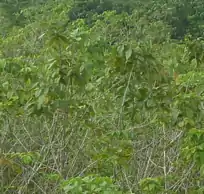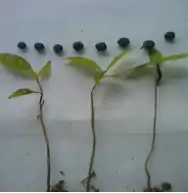Vitex pinnata
Vitex pinnata is a tree of the family Lamiaceae. It is native to south and south east Asia. It grows slowly, ultimately reaching 20 metres in height with 1–3 m. circumference trunk. It features a grey-brown-yellow bark. Its leaves are scented.
| Vitex pinnata | |
|---|---|
 | |
| Scientific classification | |
| Kingdom: | Plantae |
| Clade: | Tracheophytes |
| Clade: | Angiosperms |
| Clade: | Eudicots |
| Clade: | Asterids |
| Order: | Lamiales |
| Family: | Lamiaceae |
| Genus: | Vitex |
| Species: | V. pinnata |
| Binomial name | |
| Vitex pinnata | |
Description
Its bark is fissured, flaky, and pale yellowish grey to brown. The inner bark is pale yellow becoming green on exposure. The sapwood is soft yellow to brown. Its leaves are 3- or 5-foliolate. Leaflets are almost sessile. The outer two are usually much smaller than the others, ovate or elliptic. They are 3–25 cm long, 1.5–10 cm wide; their base is rounded to slightly wedge-shaped. The apex is acuminate; margin entire; secondary veins come in 10—20 pairs. Its inflorescences are terminal panicles. The flowers are whitish blue. The fruits are 5–8 mm in diameter; ripening black [1]
Distribution
In the Indo-Malaysia region it is found in Borneo, Sabah, Sarawak, and across Kalimantan.[2] It can be found in India, Sri Lanka and Cambodia. In the Philippines this species is known only on the islands of Palawan, Culion and Tawi-Tawi [3]
Taxonomy
V. pinnata has many depreciated synonyms, including V. pubescens and V. arborea.[4]
Ecology
It grows well usually in secondary forests, on riverbanks and along roads including on marginal land such as Imperata cylindrica area.[5][6] The species seemingly tolerates regular fires. In tropical conditions such as in East Kalimantan, flowering and fruiting are near-continuous from January to December. The fruits are eaten by birds and its seeds need light to germinate.[7]
Uses

V. pinnata has a strong and durable wood, it is durable even in contact with water or soil. It is grayish brown in color. Density is about 930 kg per cubic metre (58 lbs per cubic foot). Wood is used for posts, door and window frames, beds and furniture.
The wood is used for knife handles. The leaves and bark are used to treat abdominal pain, fever and malaria.
Conservation status
Least concern.[8]
Propagation

V. pinnata can be propagated by seeds, cuttings and wildlings. One kilogram of Vitex pinnata seeds number around 1100-1200 seeds.[9]
Sources
- Timber and its uses, Forest Department of Sri Lanka (1962).
References
- Keßler, P.J.A., 2000. A Manual to 300 selected species. Secondary forest trees of Kalimantan, Indonesia. Tropenbos Kalimantan series 3, 198
- Keßler, P.J.A., 2000. A Manual to 300 selected species. Secondary forest trees of Kalimantan, Indonesia. Tropenbos Kalimantan series 3, 198
- De Kok, R., 2008. The genus Vitex (Labiatae) in the flora Malesiana region, excluding New Guinea. KEW Bulletin. Vol 63, 17-40.
- de Kok, Rogier. 2008. The genus Vitex (Labiatae) in the Flora Malesiana region, excluding New Guinea. Kew Bulletin, 63: 17-40, doi:10.1007/s12225-007-9013-7
- Keßler, P.J.A., 2000. A Manual to 300 selected species. Secondary forest trees of Kalimantan, Indonesia. Tropenbos Kalimantan series 3, 198
- Yassir, I., Van der Kamp, J., Buurman, P., 2010. Secondary succession after fire in Imperata grasslands of East Kalimantan, Indonesia. Agriculture, Ecosystems and Environment, 137: 172-18.
- Yassir, I., Van der Kamp, J., Buurman, P., 2010. Secondary succession after fire in Imperata grasslands of East Kalimantan, Indonesia. Agriculture, Ecosystems and Environment, 137: 172-18.
- De Kok, R., 2008. The genus Vitex (Labiatae) in the flora Malesiana region, excluding New Guinea. KEW Bulletin. Vol 63, 17-40.
- Yassir, I. and Mulyana, O., 2009. Selection of tree species potential to support restoration activities in ex-coal mining site through an ecological approach. Proseding Workshop IPTEK Penyelamatan Hutan melalui Rehabilatasi Lahan Bekas Tambang Batubara. Balai Besar Penelitian Dipterokarpa. Samarinda. East Kalimantan.
